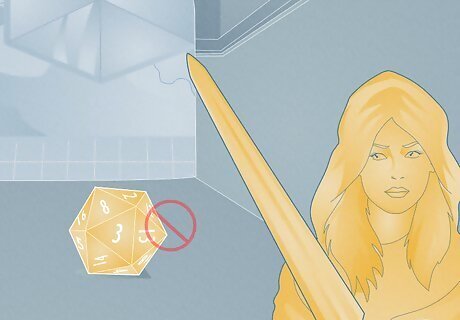
views
- Disengage is an action that prevents opportunity attacks from enemies for the rest of your PC’s turn. You can move away from enemies freely without taking damage.
- Use Disengage to retreat if your PC is wounded or needs to take cover. Or, move your PC forward and into the thick of battle without taking extra hits.
- Any creature can use Disengage regardless of class, race, or background, but some classes (like rogues and monks) have improved versions of Disengage.
What is Disengage in D&D 5e?

Disengage is an action that lets you avoid opportunity attacks. In D&D 5e, opportunity attacks are a type of reaction that combatants can use to attack an enemy who moves away from them, out of their reach. However, when your player character (PC) takes the Disengage action, their movement won’t provoke opportunity attacks for the rest of their turn. The Disengage action lets you move away from enemies (or through an enemy’s space) without letting them take a free attack on your PC. For example, if your PC were fighting a horned devil and needed to run into the next room, ordinarily, they’d provoke an opportunity attack for moving more than 10 feet (the extent of the devil’s reach) away. However, you could use the Disengage to run into the next room more than 10 feet away, and the horned devil wouldn’t be able to take an attack of opportunity.

Using Disengage prevents you from taking other actions in a turn. The main downside to Disengage is that it costs an action to use—and, since you generally only get 1 action per turn (unless you're under the effects of certain spells, like Haste), you won’t be able to make an attack, cast a spell that costs 1 action, or take any other actions on the same turn. Disengage is still an effective mechanic, but many players use it sparingly (and mainly during emergencies) because using a different action is more appealing.
How to Use Disengage

Use Disengage as a protective and defensive measure in battle. If your PC is low on hit points (which measure their health and the amount of damage they can take) and within range of an enemy, take the Disengage action to help them slip away and retreat into cover without provoking an attack. You can also use Disengage defensively to: Protect allies. If you need to get to one of your allies because they’re being threatened by an enemy, use Disengage to reach them fast without getting attacked. Hit-and-run. Can your PC use Disengage as a bonus action? Run in, attack an enemy, then Disengage and take cover again to remain out of reach. Pass enemies. Anytime you need to get from one point to another in a battle, you can Disengage beforehand to avoid opportunity attacks.

Threaten enemies and position your PC strategically with Disengage. Disengage isn’t just a defensive move—you can use it to put your PC on the offense! Enemies at the back of the fight (especially spellcasters and archers) may be harder to reach—but with Disengage, you can run across the battlefield without getting attacked and square off against those enemies. Once you’re within melee range of enemies, they’ll also have to decide whether disengaging is worth it if they want to get away—and if they Disengage, they won’t be able to take another action, which benefits your PC. You can also use Disengage to position your PC in the right spot for an area-of-effect ability. Say you want to cast Arms of Hadar; since the spell has a 10-foot radius, you might want to position your PC in the middle of a group of enemies before unleashing it. Using Disengage can help you get there without taking any hits.
Which classes can Disengage?

Any class, monster, or NPC can use the Disengage action. Disengage is one of the few universal actions in D&D 5e; there are no restrictions on who (or what) can use it, from your PC to the mind flayer or ancient red dragon they’re fighting. Still, certain classes and playable races can use improved versions of the Disengage action, including: Rogues. Rogues get the 2nd-level Cunning Action feature, which lets them Disengage as a bonus action—meaning they can Disengage and still attack or take a full action on the same turn. Monks. Monks get the 2nd-level Step of the Wind feature, which lets them Disengage as a bonus action and double their jump distance for a turn. Keep in mind that this feature costs 1 ki point to use. Goblins. Any goblin PC (or enemy) has the Nimble Escape trait, which allows them to Disengage as a bonus action (much like a rogue).
Disengage vs. Dodge

Disengage avoids opportunity attacks, while Dodge affects all attack rolls. While both are defensive actions, they have different uses. Dodge is all about reducing the likelihood of getting hit; it imposes disadvantage on attacks against your PC until the start of their next turn. Disengage is designed to be an escape, outright preventing opportunity attacks for the rest of your PC’s turn. Thus, each action should be used strategically. Before picking one, figure out what your PC needs (and what the situation calls for). If your PC is staying in the same spot but needs more defense, have them take the Dodge action. If your PC needs to run away, the Disengage action would likely be more helpful.
Does Disengage affect the Sentinel feat?

Disengage has no effect against the Sentinel feat. In D&D 5e, Sentinel is an optional feat that grants abilities designed to drop an enemy’s guard. According to the feat’s rules, any creature moving away from a PC with the Sentinel feat still provokes opportunity attacks—even if they Disengage. In other words, Sentinel beats Disengage, negating its effects. Say you have a PC with the Sentinel feat, and the ogre you’re fighting attempts to disengage and run away. Since your PC has the Sentinel feat, they could take an opportunity attack on the ogre regardless, even if other allies without the Sentinel feat couldn’t.
Alternatives to Disengage

Many classes have abilities that work similarly to the Disengage action. Specifically, those abilities can move a PC outside an enemy’s reach (or push an enemy away from them) without provoking an opportunity attack. Since the rules for opportunity attacks specify that creatures must move deliberately, teleportation and forced movement (like push and pull effects) don’t trigger attacks. For example: Shove. While any PC can Shove a foe, Strength-based characters are more likely to succeed. Pushing foes (or allies) 5 feet away won’t trigger any opportunity attacks. Fancy Footwork. Available to Swashbuckler subclass rogues, this feature lets you move away from foes you attack without using Disengage. Command. Using the Command spell, you can order enemies to move away from you and expend their movement for that turn, giving you a chance to get away. Dissonant Whispers. Like Command, the Dissonant Whispers spell can also force enemies to expend their movement and retreat. Repelling Blast. The warlock invocation Repelling Blast can push an enemy back, allowing your allies to retreat without getting attacked. Telekinetic. This is an optional feat; with it, you can forcibly move an enemy that fails a Strength saving throw 5 feet away. Teleportation spells. Want to get away in a hurry without Disengaging? Any spell that involves teleportation—like Misty Step, Dimension Door, or Teleport—can do the trick.




















Comments
0 comment